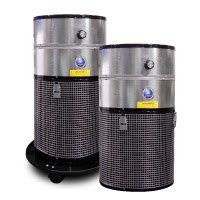 If the 4.9 million barrels of oil that spilled into the Gulf of Mexico during the 2010 Deep Water Horizon spill was a ecological disaster, the two million gallons of dispersant used to clean it up apparently made it even worse – 52-times more toxic. That’s according to new research from the Georgia Institute of Technology and Universidad Autonoma de Aguascalientes (UAA), Mexico.
If the 4.9 million barrels of oil that spilled into the Gulf of Mexico during the 2010 Deep Water Horizon spill was a ecological disaster, the two million gallons of dispersant used to clean it up apparently made it even worse – 52-times more toxic. That’s according to new research from the Georgia Institute of Technology and Universidad Autonoma de Aguascalientes (UAA), Mexico. The study found that mixing the dispersant with oil increased toxicity of the mixture up to 52-fold over the oil alone. In toxicity tests in the lab, the mixture’s effects increased mortality of rotifers, a microscopic grazing animal at the base of the Gulf’s food web. The findings are published online by the journal Environmental Pollution and will appear in the February 2013 print edition.
Using oil from the Deep Water Horizon spill and Corexit, the dispersant required by the Environmental Protection Agency for clean up, the researchers tested toxicity of oil, dispersant and mixtures on five strains of rotifers. Rotifers have long been used by ecotoxicologists to assess toxicity in marine waters because of their fast response time, ease of use in tests and sensitivity to toxicants. In addition to causing mortality in adult rotifers, as little as 2.6 percent of the oil-dispersant mixture inhibited rotifer egg hatching by 50 percent. Inhibition of rotifer egg hatching from the sediments is important because these eggs hatch into rotifers each spring, reproduce in the water column, and provide food for baby fish, shrimp and crabs in estuaries.
“Dispersants are preapproved to help clean up oil spills and are widely used during disasters,” said UAA’s Roberto-Rico Martinez, who led the study. “But we have a poor understanding of their toxicity. Our study indicates the increase in toxicity may have been greatly underestimated following the Macondo well explosion.”
Martinez performed the research while he was a Fulbright Fellow at Georgia Tech in the lab of School of Biology Professor Terry Snell. They hope that the study will encourage more scientists to investigate how oil and dispersants impact marine food webs and lead to improved management of future oil spills.
“What remains to be determined is whether the benefits of dispersing the oil by using Corexit are outweighed by the substantial increase in toxicity of the mixture,” said Snell, chair of the School of Biology. “Perhaps we should allow the oil to naturally disperse. It might take longer, but it would have less toxic impact on marine ecosystems.”


















